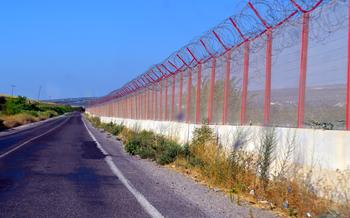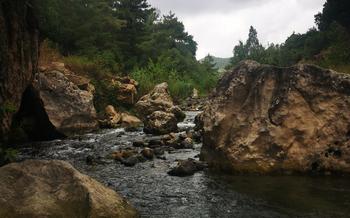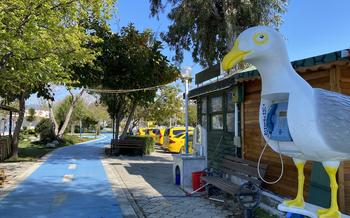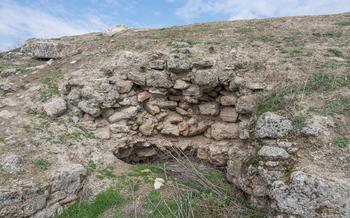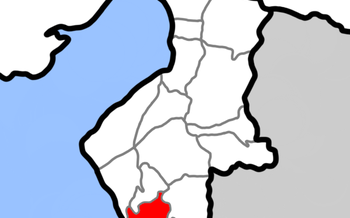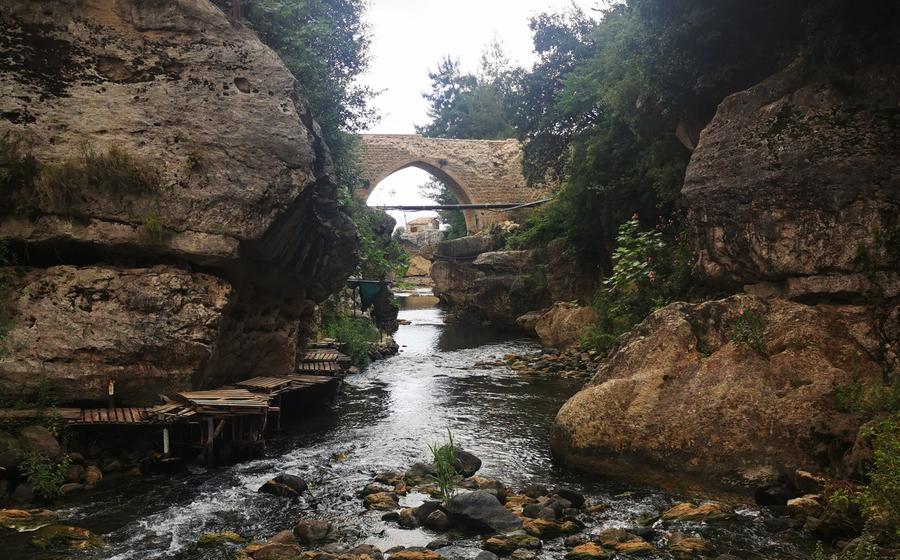
Daphne (Harbiye) Ancient City
- History of Daphne (Harbiye) Ancient City
- How to Get to Daphne (Harbiye) Ancient City
- Entrance Fees and Opening Hours
- What to See at Daphne (Harbiye) Ancient City
- Temple of Apollo
- Church of St. Simeon Stylites: A Testament to Faith and Devotion
- Other Notable Ruins
- Natural Beauty of the Site
- Local Cuisine and Hospitality
- Photography Opportunities
- Combining with Other Attractions
- Local Festivals and Events
- Tips for a Memorable Visit
- An Insider's Secret:
History of Daphne (Harbiye) Ancient City
Nestled in the heart of the Hatay region, Daphne (Harbiye) Ancient City stands as a testament to the rich cultural tapestry of Turkey. The city's history stretches back to the 3rd century BC, when it was founded by the Seleucid dynasty as a religious center dedicated to the Greek god Apollo. During the Hellenistic and Roman periods, Daphne flourished as a place of pilgrimage, attracting visitors from across the ancient world who sought to pay homage to the oracle of Apollo. As Christianity gained prominence, the city transformed into a significant Christian center, with the construction of churches and monasteries. However, its decline began during the Byzantine era, and it was eventually abandoned in the Middle Ages. The rediscovery of Daphne in the 19th century sparked renewed interest in its history, and today, it stands as an important archaeological site, inviting visitors to explore its ancient ruins and uncover the secrets of its storied past.
How to Get to Daphne (Harbiye) Ancient City
Reaching Daphne (Harbiye) Ancient City is a breeze from Antakya. Hop on the local public transportation, which conveniently drops you right at the entrance of the site. If you prefer a more flexible option, renting a car is a great choice. Follow the scenic roads and enjoy the picturesque surroundings as you make your way to the ancient city. Ample parking is available near the entrance, so you can park your car and start exploring without any hassle. To delve deeper into the history and significance of the site, consider hiring a local guide. These knowledgeable individuals can provide fascinating insights and bring the ancient ruins to life. Guided tours are also available, offering a comprehensive exploration of the site's highlights. Whichever option you choose, getting to Daphne (Harbiye) Ancient City is easy and hassle-free, ensuring a seamless start to your journey through history.
Entrance Fees and Opening Hours
Visiting Daphne (Harbiye) Ancient City comes with an affordable admission fee that allows visitors to explore its rich history and stunning ruins. The precise cost may vary, so it's advisable to consult the latest official sources for the most accurate information.
The ancient city's gates are open to the public, inviting travelers to step back in time and immerse themselves in its wonders. The opening hours generally align with the standard operating times of other historical sites in the region. However, seasonal variations may occur, and it's worth checking in advance to avoid any inconvenience.
To fully appreciate the ancient city's grandeur, consider visiting during the shoulder months (spring and autumn) when the weather is pleasant, and the crowds are smaller. This will ensure a more intimate and enjoyable experience, allowing you to fully soak in the atmosphere and capture the essence of this remarkable place.
What to See at Daphne (Harbiye) Ancient City
As you step into the ancient city of Daphne, prepare to be captivated by a treasure trove of ruins and attractions that tell the story of its rich and storied past. Among the most prominent landmarks is the Temple of Apollo, a testament to the city's religious significance. With its impressive columns and well-preserved structure, it stands as a symbol of the grandeur that once defined Daphne.
Another remarkable sight is the Church of St. Simeon Stylites, a unique architectural marvel that draws visitors from around the world. Perched atop a pillar, this church is a testament to the devotion and asceticism of St. Simeon Stylites, who spent decades in seclusion on this very spot. The intricate mosaics and carvings that adorn the church walls depict biblical scenes and historical events, adding to its allure and significance.
Beyond these iconic landmarks, Daphne boasts a wealth of other notable ruins that offer glimpses into the daily life and culture of its ancient inhabitants. Explore the Roman baths, where citizens once sought rejuvenation and relaxation. Marvel at the aqueduct, an engineering feat that brought water to the city from distant sources. Stroll through the residential areas, where the foundations of homes and shops hint at the bustling urban center that once thrived here.
As you wander through the ancient city, take the time to appreciate the smaller details that contribute to its charm. Intricate carvings on stone blocks, fragments of pottery, and ancient inscriptions scattered throughout the site offer a tangible connection to the past. Let your imagination run wild as you picture the streets teeming with life, the sounds of commerce and conversation filling the air, and the vibrant energy that characterized this once-thriving metropolis.
Temple of Apollo
The Temple of Apollo, a testament to architectural grandeur, stands as the centerpiece of Daphne (Harbiye) Ancient City. Dedicated to the Greek god of music and prophecy, this sacred edifice exudes an aura of timeless spirituality. Remarkably well-preserved, its towering columns, intricately carved with mythological scenes, transport visitors back to a bygone era.
As you approach the temple, its sheer size and majesty are awe-inspiring. The intricate details on the columns depict tales from Greek mythology, inviting you to delve into the realm of gods and heroes. The temple's harmonious proportions and elegant design create a sense of serenity, conducive to contemplation and introspection.
Step inside the temple and marvel at the vastness of its interior. The soft light filtering through the columns casts an ethereal glow, illuminating the remnants of ancient frescoes and mosaics. Imagine the grandeur of religious ceremonies and rituals that once took place within these sacred walls, echoing with prayers and hymns to Apollo.
Take a moment to absorb the temple's rich history. Once a place of pilgrimage for devout worshippers seeking guidance and oracles, it now stands as a symbol of Daphne's enduring legacy. As you wander through the temple, let the whispers of ancient spirits guide you, transporting you to a time when gods and mortals coexisted in harmony.
Church of St. Simeon Stylites: A Testament to Faith and Devotion
In the heart of Daphne (Harbiye) Ancient City, nestled amidst the ruins and remnants of a bygone era, stands the Church of St. Simeon Stylites, a monument to unwavering faith and devotion. This extraordinary structure, built around a pillar where the eponymous saint spent decades in seclusion, is a testament to the enduring power of religious conviction.
The church's architecture is as unique as its history. Constructed around a towering pillar, it allowed St. Simeon to live in isolation while still being visible to his followers. The intricately carved capitals and decorative elements that adorn the pillar reflect the artistry and craftsmanship of the period.
The interior of the church is adorned with stunning mosaics and carvings that depict biblical scenes and historical events. These intricate artworks provide a glimpse into the beliefs and practices of early Christianity and add to the church's allure.
St. Simeon Stylites, a Syrian ascetic, gained fame for his extreme practices of self-denial and his ability to withstand prolonged periods of isolation. He spent decades perched atop a pillar, enduring harsh weather conditions and physical discomfort in pursuit of spiritual enlightenment.
The Church of St. Simeon Stylites stands as a reminder of the profound impact of religious devotion and the lengths to which individuals have gone in their pursuit of spiritual transcendence. It is a site of pilgrimage and a place of awe and inspiration for visitors from all walks of life.
Other Notable Ruins
In addition to the grand Temple of Apollo and the awe-inspiring Church of St. Simeon Stylites, Daphne (Harbiye) Ancient City is home to several other notable ruins and structures that offer glimpses into its rich history and vibrant past.
Explore the Roman Baths: Step into the well-preserved remains of the Roman baths, a testament to the advanced engineering and hygiene practices of the ancient Romans. Picture yourself bathing in these communal pools, surrounded by intricate mosaics and frescoes that once adorned the walls.
Admire the Aqueduct: Marvel at the impressive aqueduct that once supplied Daphne with fresh water. Gaze upon its towering arches, evidence of Roman ingenuity in water management and infrastructure. Imagine the gushing water flowing through these channels, sustaining the life and prosperity of the ancient city.
Stroll through the Residential Areas: Wander among the ruins of residential areas, where ordinary citizens of Daphne once lived. Explore the foundations of houses, shops, and public buildings, piecing together the daily lives of the people who inhabited this ancient metropolis. Discover hidden courtyards, mosaic floors, and remnants of domestic life that bring the past vividly to life.
These lesser-known ruins, though smaller in scale, offer a comprehensive understanding of Daphne (Harbiye) Ancient City and its diverse architectural heritage. They invite visitors to connect with the everyday lives of its inhabitants and gain a deeper appreciation for the complexity and richness of this ancient urban center.
Natural Beauty of the Site
Amidst the ruins of Daphne (Harbiye) Ancient City, visitors are greeted by a serene and picturesque setting that harmonizes perfectly with the historical significance of the site. Lush greenery and tranquil waters surround the ancient city, creating a tranquil oasis that invites visitors to relax and soak in the serene atmosphere. The abundance of flora and fauna that call the site home adds to its charm, creating a harmonious blend of history and nature. Visitors can wander through the ruins, marveling at the architectural wonders of the past while simultaneously enjoying the tranquility of the natural surroundings, making their visit to Daphne (Harbiye) Ancient City a truly immersive and unforgettable experience.
Local Cuisine and Hospitality
The Hatay region is renowned for its exceptional cuisine, a harmonious blend of Turkish and Middle Eastern flavors that reflects the region's rich cultural heritage. Visitors to Daphne (Harbiye) Ancient City will find themselves spoilt for choice when it comes to dining options.
Numerous restaurants and eateries in the vicinity offer a delectable array of traditional dishes. Savor the aromatic flavors of freshly grilled kebabs, indulge in the creamy goodness of hummus and baba ghanoush, or tantalize your taste buds with the tangy spices of local stews. Vegetarians will delight in the variety of mezzes and salads, showcasing the region's fresh produce and culinary creativity.
Beyond the culinary delights, Hatay is known for its warm hospitality and friendly people. The locals take pride in welcoming visitors and ensuring they have a memorable experience. Whether it's a friendly smile or a helping hand, you'll find the people of Hatay eager to assist and make your visit to Daphne (Harbiye) Ancient City truly special.
Photography Opportunities
The ancient ruins, lush greenery, and vibrant colors of Daphne (Harbiye) Ancient City present a feast for the eyes and a paradise for photographers. The well-preserved Temple of Apollo, with its towering columns and intricate carvings, is a particularly popular subject. The Church of St. Simeon Stylites, with its unique architecture and stunning mosaics, is another must-capture sight. For nature enthusiasts, the surrounding landscape offers a variety of photogenic opportunities, from the tranquil waters of the lake to the diverse flora and fauna that call the site home.
To make the most of your photography experience, it's important to consider the lighting conditions. The early morning and late afternoon light is often the most flattering, casting a warm glow on the ruins. Tripod use is recommended for low-light conditions or to achieve long exposure shots. Remember to be respectful of the historical significance of the site and avoid using flash photography inside the buildings.
Whether you're a seasoned photographer or simply enjoy capturing memories, Daphne (Harbiye) Ancient City will provide you with countless opportunities to create stunning images that will transport you back in time.
Combining with Other Attractions
Daphne (Harbiye) Ancient City is just one of many fascinating attractions in the Hatay region. To make the most of your visit, consider combining it with other nearby sites to create a comprehensive and enriching experience.
-
Antakya Archaeological Museum: Located in the heart of Antakya, this museum houses a vast collection of artifacts from Daphne and other ancient sites in the region. It offers a deeper insight into the history, culture, and daily life of the ancient inhabitants.
-
Habibi Neccar Mosque: This historic mosque, also known as the Tomb of St. Peter, is believed to be the burial place of one of Jesus's disciples. It is a sacred site for both Muslims and Christians, and its unique architecture blends Islamic and Byzantine elements.
-
St. Pierre Church: This 19th-century church is dedicated to St. Peter and is located in the picturesque village of Samandağ. It boasts stunning views of the Mediterranean Sea and is a popular pilgrimage site for Christians.
-
Titus Tunnel: This ancient tunnel, located near Samandağ, was built by the Roman Emperor Titus to divert the course of the Orontes River. It is an impressive feat of engineering and offers a glimpse into the region's rich history.
To easily travel between these attractions, you can either rent a car or utilize the local transportation system. Buses and taxis are readily available and provide convenient connections to all the major sites. With careful planning, you can create a personalized itinerary that allows you to explore the diverse cultural and historical treasures of the Hatay region.
Local Festivals and Events
The Hatay region is renowned for its vibrant cultural heritage, which is reflected in various festivals and events held throughout the year. While visiting Daphne (Harbiye) Ancient City, one should consider aligning their trip with these events to immerse themselves fully in the region's rich traditions.
One such significant event is the annual Daphne Festival, which celebrates the history and legacy of the ancient city. During this festival, visitors can witness traditional performances, participate in cultural workshops, and savor local delicacies. The festival provides an excellent opportunity to engage with the local community, learn about their customs, and gain a deeper understanding of the region's cultural heritage.
Moreover, the Hatay region is home to several religious festivals that attract pilgrims and visitors alike. The most notable is the Feast of St. Simeon Stylites, held annually to commemorate the life and teachings of the revered saint. During this feast, pilgrims gather at the Church of St. Simeon Stylites to pay homage and participate in special ceremonies. Attending these festivals offers a unique glimpse into the region's religious traditions and the enduring legacy of its spiritual figures.
Whether it's the vibrant Daphne Festival or the solemn Feast of St. Simeon Stylites, these events provide visitors with an opportunity to connect with the local culture, celebrate the region's heritage, and create lasting memories of their time in Hatay.
Tips for a Memorable Visit
To enhance your experience at Daphne (Harbiye) Ancient City, keep these practical tips in mind:
-
Wear comfortable shoes: The ancient city's terrain can be uneven, so sturdy and comfortable footwear is essential for navigating the site.
-
Bring water and sunscreen: The weather in Hatay can be hot and sunny, so staying hydrated and protected from the sun is important.
-
Allow enough time: Don't rush your visit. Allocate at least two to three hours to explore the site thoroughly and appreciate its historical significance.
-
Capture the essence: If you're artistically inclined, bring a sketchbook or paints to capture the ancient city's beauty through sketches or paintings. Alternatively, keep a journal to record your thoughts and impressions as you explore.
-
Respect the site: Remember that Daphne (Harbiye) Ancient City is a historical and archaeological treasure. Refrain from touching or climbing on the ruins, and avoid littering to preserve the site's integrity for future generations.
An Insider's Secret:
Venture beyond the main ruins of Daphne to discover the hidden gem of the ancient city's aqueduct. Follow the path that leads away from the Temple of Apollo, and you'll be rewarded with a breathtaking sight. The aqueduct, with its series of arches and channels, once carried water to the city from a distant source. Imagine the engineering prowess of the ancients as you marvel at this marvel of hydraulic engineering. As you stand amidst these ruins, you'll feel a profound connection to the past, transported back to a time when Daphne was a thriving metropolis. Let the whispers of history guide you as you explore this hidden treasure, a testament to the enduring legacy of this remarkable ancient city.

